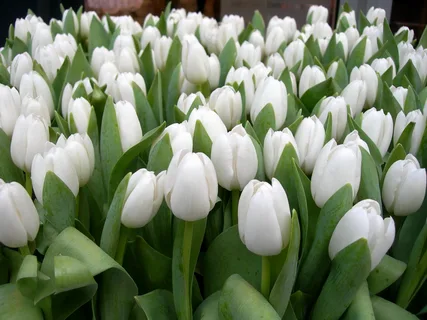White tulips, with their pristine petals and elegant form, have captivated hearts and minds for centuries. Beyond their aesthetic appeal, these flowers are imbued with rich symbolism and cultural significance. This comprehensive guide delves into the multifaceted meanings of white tulips, exploring their historical roots, cultural interpretations, and the occasions where they hold special relevance.
The Essence of White Tulips
Symbolism of Purity and Innocence
White tulips are universally recognized as symbols of purity and innocence. Their unblemished white petals evoke a sense of cleanliness and simplicity, making them a popular choice for events that celebrate new beginnings and untainted emotions. In many cultures, white tulips are associated with fresh starts and are often used in ceremonies that mark significant life transitions.
Expressions of Forgiveness and Apology
In the language of flowers, white tulips convey messages of forgiveness and sincere apologies. Presenting someone with a bouquet of white tulips can be a heartfelt way to express remorse and seek reconciliation. Their association with forgiveness makes them suitable for mending strained relationships and expressing genuine contrition.
Cultural and Historical Significance
Origins and Historical Context
Tulips originated in Central Asia and were cultivated by the Persians as early as the 10th century. They gained prominence in the Ottoman Empire, where they were considered symbols of paradise on earth. The name “tulip” is derived from the Turkish word for turban, reflecting the flower’s turban-like shape.
In the 16th century, tulips were introduced to Europe and became highly sought after, leading to “Tulip Mania” in the Netherlands—a period where tulip bulbs were traded at extraordinarily high prices. White tulips, in particular, were prized for their rarity and beauty.
White Tulips in Eastern and Western Cultures
In Eastern cultures, white flowers, including tulips, are often associated with purity and spiritual enlightenment. They are used in religious ceremonies and are seen as symbols of reverence and respect.
In Western cultures, white tulips are commonly used in weddings and funerals. Their association with purity makes them ideal for bridal bouquets, while their symbolism of remembrance and peace makes them appropriate for honoring the deceased.
White Tulips in Special Occasions
Weddings
White tulips are a popular choice for weddings due to their symbolism of purity, new beginnings, and deep love. They complement the traditional white wedding dress and add an element of elegance to the ceremony. Incorporating white tulips into wedding decor can enhance the romantic and serene atmosphere of the event.
Funerals and Memorials
The serene beauty of white tulips makes them suitable for funerals and memorial services. They symbolize respect, remembrance, and the hope for peace in the afterlife. Offering white tulips during times of mourning conveys sympathy and honors the memory of the departed.
Apologies and Reconciliation
When words fall short, white tulips can serve as a non-verbal apology. Their association with forgiveness makes them an appropriate gesture to mend relationships and express sincere regret. Presenting white tulips can open the door to healing and renewed connections.
Botanical Characteristics
Physical Attributes
White tulips are characterized by their cup-shaped blooms and smooth, elongated petals. Each flower typically has six petals, and the plant’s height can range from 10 to 24 inches, depending on the variety. The leaves are broad and lance-shaped, providing a lush green backdrop to the striking white flowers.
Blooming Season
Tulips are spring-blooming perennials. White tulips, like other varieties, generally bloom from early to late spring, depending on the specific type and local climate conditions. They thrive in well-drained soil and require a period of cold dormancy to bloom successfully.
Symbolism in Dreams and Numerology
Dream Interpretations
Dreaming of white tulips is often interpreted as a sign of new beginnings and personal growth. Such dreams may indicate a desire for purity in one’s life or the need to forgive and move forward from past grievances.
Numerological Significance
In numerology, the number six is associated with harmony, balance, and nurturing. Given that tulips have six petals, they embody these qualities, symbolizing a harmonious and balanced approach to life and relationships.
White Tulips in Art and Literature
White tulips have inspired artists and writers throughout history. Their delicate beauty and profound symbolism have made them subjects in paintings, poetry, and literature. They often represent themes of love, purity, and the transient nature of life.
Conclusion
White tulips are more than just beautiful flowers; they are rich in symbolism and cultural significance. Whether used to express purity, seek forgiveness, or honor a loved one, white tulips convey deep emotions and messages. Their timeless elegance and profound meanings make them a cherished choice for various occasions, resonating with people across different cultures and generations.
- Sheffield United vs Sunderland LIVE: Championship play-off final result, match stream and latest updates toda - June 5, 2025
- Tulsi Gabbard Net Worth - June 5, 2025
- Explore New Mexico’s THC Infused Beverages - June 5, 2025







